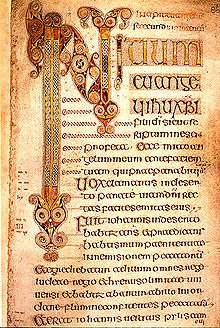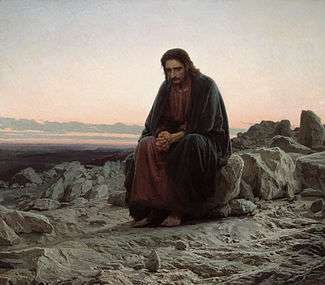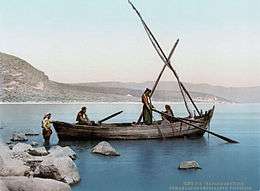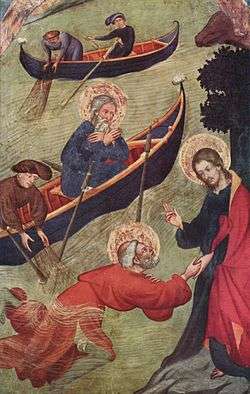Mark 1
| Mark 1 | |
|---|---|
 Image of page from the 7th century Book of Durrow, from The Gospel of Mark. Trinity College Dublin | |
| Book | Gospel of Mark |
| Bible part | New Testament |
| Order in the Bible part | 2 |
| Category | Gospel |
| Gospel of Mark |
|---|
Mark 1 is the first chapter of the Gospel of Mark of the New Testament of the Christian Bible.
Verse 1
- The beginning of the gospel of Jesus Christ, the Son of God[1]
The opening verse of the Gospel of Mark states right from the start Mark's belief. However, because there is no article in the Koine Greek some have suggested (ιησου χριστου υιου του θεου 1:1) be translated "...a Son of God". Robert Miller translates it as "The good news of Jesus the Anointed"[2] on the basis that χριστου means "anointed" and the phrase υιου του θεου is not present in a few early witnesses. The "beginning" could refer to the beginning of the book, or the next verse,[3] or the beginning of the story of Jesus, as Mark is only beginning to tell you about Jesus' life, not writing his entire biography.[4]
By saying he is the anointed, Mark is declaring Jesus the Messiah, the successor to King David. Mark always uses "Christ" which is derived from the Greek translation, he never uses "Messias" (Strong's G3323) which is derived from the Greek transliteration of the Aramaic word for "Messiah". Son of God can be seen as synonymous with a political messiah, in this case the King of the Jews, but can also be seen as expressing divinity,[5] as in the phrase "God the Son". Only the demonic opponents of Jesus call him this in Mark until the centurion in Mark 15:39. The good news could refer to the news about Jesus or from Jesus or Jesus as the good news or a combination of them all.[6]
Henry Barclay Swete's Introduction to the Old Testament in Greek, pages 456-457 states:
- "Εὐαγγέλιον [Good news or Gospel] in the LXX occurs only in the plural, and perhaps only in the classical sense of 'a reward for good tidings' (2 Sam 4:10 [also 18:20, 18:22, 18:25-27, 2 Kings 7:9]); in the N.T. it is from the first appropriated to the Messianic good tidings (Mark 1:1, 1:14), probably deriving this new meaning from the use of εὐαγγέλίζεσθαι in Isa 40:9, 52:7, 60:6, 61:1."
John the Baptist

Mark introduces verses 2 and 3 with "It is written in Isaiah the prophet:", however his quote does not exactly match any extant Book of Isaiah, not even those found in the Dead Sea Scrolls. Some manuscripts of Mark instead have "... in the prophets".[7] Some think this might indicate he did not use a complete Jewish Bible but instead used a general collection of quotations from them.[8] The quote appears to be a composite from the books of Exodus, Malachi and Isaiah: Exodus 23:20, Malachi 3:1 and Isaiah 40:3,[9] linking the gospel of Jesus with a fulfillment of the "Old Testament". Mark assumes these refer to John the Baptist.
The passage from Malachi describes one who will prepare the way of God for God. Mark has changed the statement of Malachi, which refers to Elijah returning to prepare God's way, to one in which John is seen as Elijah, because the spirit of Elijah rested on him and "my" way has been changed to "your" way, i.e. Jesus' way. Mark thus might be equating Jesus with God.[10]
In more detail, it appears Mark has taken part of Exodus 23:20 of the Septuagint: ιδου εγω αποστελλω τον αγγελον μου προ προσωπου σου ( Brenton Ex 23:20: "behold, I send my angel before thy face") and combined it with part of Malachi 3:1 of the Septuagint: επιβλεψεται οδον (Brenton Mal 3:1: "survey the way") to create Mark 1:2 in the Westcott-Hort Greek NT: ιδου αποστελλω τον αγγελον μου προ προσωπου σου ος κατασκευασει την οδον σου. The significant differences are επιβλεψεται ("survey" -Brenton) is replaced with κατασκευασει ("prepare" -NRSV) and a final σου ("your" -NRSV) has been added: "See, I am sending my messenger ahead of you,[11] who will prepare your way" (Mark 1:2 in the NRSV). The following quote of Isaiah 40:3 is specifically from the Septuagint,[12] compare Brenton Isa 40:3: "The voice of one crying in the wilderness, Prepare ye the way of the Lord, make straight the paths of our God." to the Masoretic Text 40:3: "Hark! one calleth: 'Clear ye in the wilderness the way of the LORD, make plain in the desert a highway for our God." or the NRSV 40:3: "A voice cries out: ‘In the wilderness prepare the way of the Lord, make straight in the desert a highway for our God." or the new JPS Tanakh (1985) 40:3: "A voice rings out: Clear in the desert A road for the Lord! Level in the wilderness A highway for our God!"
All four gospels use the quote from Septuagint Isaiah. It is in Luke in Luke 3:4-6, Matthew in Matthew 3:3, and John in John 1:23. This section of Isaiah is about the return journey home from the Babylonian captivity and was a passage Jews often used as a way of expressing the help of God. Isaiah probably uses this passage symbolically to describe moral cleansing and renewal.[8] Thus John is linked to Isaiah as well and once again Mark equates the lord of this passage, Yahweh, with Jesus.[13] Some see John's statement patterned on the Book of Exodus, in Exodus 23:20.[8] Other books used this pattern to describe other prophets, such as Hosea in 2:14 and 12:9.[2]
Mark then describes John's activities, preaching repentance and forgiveness of sins and baptising in the Jordan river. He says he wore camel hair, a leather belt, and survived off locusts and wild honey. His clothes resemble Elijah's described in 2 Kings 1:8. There is also the prophecy of true prophet's clothing in the Book of Zechariah 13:4. His diet may have been his attempt at purity[8] There has been much speculation that John was an Essene, perhaps also Jesus, but there is no hard evidence either way. According to Luke, Jesus and John were relatives (Luke 1:36) and John is described as being a Nazarite from birth (Luke 1:15). All portraits of him paint him as certainly an ascetic, but also as a popular and respected preacher.
This portrait of John is somewhat the same but somewhat different from the one Josephus gives us. Josephus states that John baptized, but not for the forgiveness of sins and that he was a great leader of the people, making no mention of Jesus regarding John. This difference might show how Mark views John, as a representative of Elijah and merely the herald of who Mark deems the more important, Jesus.[8] According to the Q hypothesis John baptising was also found at the beginning of that book as well.[14] John is revered in Mandaeism.
Many people come to be baptised by John. He tells them "After me will come one more powerful than I, the thongs of whose sandals I am not worthy to stoop down and untie. I baptize you with water, but he will baptize you with the Holy Spirit." Untying someone's sandals was a task commonly done by someone's slave.[8] What baptising with the Holy Spirit refers to, as Jesus never baptises in Mark, is uncertain if one only considers Mark. John 4:1-3 has Jesus' disciples (but not Jesus) baptising at the same time as John the Baptist. (See also Paraclete, Acts 1:5, 1:8, 2:4, 2:38.) Matthew 3:11 and Luke 3:16 specify baptism with holy spirit and fire.
The Jesus Seminar concluded that this was one of the authentic ("red") acts of Jesus, recorded in Mark 1:1-8, Matt 3:1-12, Luke 3:1-20, Gospel of the Ebionites 1, and which it calls "A voice in the wilderness".
Jesus' baptism and temptation
_-_Google_Art_Project.jpg)
Jesus is one of the many who come to be baptised, in his case from Nazareth in Galilee. Since John, according to Mark, baptised repentance for the forgiveness of sins ( Mark 1:4) some have argued Jesus also is coming to be forgiven for his sins; but Mark notes that John says that he is unworthy ( Mark 1:7-8) . Mark also has John's function as preparing things for Jesus, and some argue this baptism is meant to forward the fulfillment of Jesus' plan. John 1:31 has John say his baptism was his method of revealing Jesus to Israel. Perhaps Jesus is doing this to embrace the doctrine of baptism and repentance of sins and his oneness with those who embrace it.[15] The Epistle to the Hebrews, in Hebrews 4:15, says Jesus was "just as we are—yet was without sin" and 1 John 3:4 states: "...sin is lawlessness."
Mark introduces Jesus without a history or a description, suggesting the intended reader already has heard of him. Mark, like all the Gospels, gives no physical description of Jesus, unlike the short previous description of John. Mark's readers are presumed to already know about the two of them.[2]
John baptizes him and Jesus then sees a theophany. He sees "heaven being torn open and the spirit descending on him like a dove." (Mark 1:10), telling him that he is his son whom he loves and is pleased with. This could be related to a Psalm, Psalm 2:7, as well as Isaiah 42:1.[16] The opening of the heavens is often seen as the union and beginning of communication between God and the world. Whether anyone else besides Jesus saw this has been often debated. Luke 3:22 says the Spirit descended in "bodily" form. John 1:32-34 says John said he saw the Spirit descend onto Jesus. Some have speculated that this event may have been a story that has its origins in the Early Christian practice of baptism, but Robert J. Karris argues that is unlikely.[8]
Some have argued that since Mark begins his story here, at the baptism, that this could be seen as a form of adoption, as it is God's action which changed Jesus' life, although Mark probably is confirming the two's preexistent relationship[8] Jesus is never declared as God's adopted son anywhere in the book, but Mark does not exactly state how or when Jesus became God's son. Both Matthew and Luke use their infancy narratives to show he was God's son from the moment of conception, and John 1:1 has him as the word of God from the moment of creation.[16]
The voice from heaven calls Jesus "beloved". Some see a relationship between this description and that of Isaac in Genesis 22, where Abraham had shown his devotion to God by being willing to sacrifice his son, so God shows his love for humanity by actually sacrificing his son, see also Substitutionary atonement. There is also the possible link with this and the beloved servant of God in Isaiah 42:1-7, 49:1-6, 50:4-11, and 52:13-53:12.[17]

The spirit then "At once", Kai euthys (Strong's G2117), sends him out into the desert to be tempted by Satan for forty days. Forty is a common numerological device in the Bible, such as the forty days of the flood in Genesis 7 and the forty years of the Israelites wandering in the desert in Exodus. Elijah also spent forty days and nights travelling to Mount Horeb in 1 Kings 19:8. Unlike Matthew 4:1-11 and Luke 4:1-13 the number of temptations or what they were are not described. Mark does say that Angels came to minister to him. Karris argues the angels and the wilderness are related to Psalm 91:11-13.[8]
John is put into prison, presumably by Herod Antipas. Mark uses the term paradothēnai (Strong's G3860) to describe John being turned over, which Mark also uses to describe Jesus being arrested during his Passion. Mark has already highlighted two themes, Jesus' power from and favor of God, contrasted with his confrontation with Satan and John being arrested, showing his power and mission have already encountered the most extreme challenges both from the authorities of this world and supernatural powers.
The Jesus Seminar concluded that parts of these accounts were authentic ("red") acts of Jesus, specifically: "John baptizes Jesus": Mark 1:9-11, Matt 3:13-17, Luke 3:21-22, Gospel of the Ebionites 4, and "Jesus proclaims the gospel": Mark 1:14-15.
Calling of the four disciples



Jesus then goes into Galilee, preaching "The kingdom of God is near (ēngiken). Repent and believe the gospel (euangelion)!" The kingdom of God can be seen as a physical or spiritual place. It could also be translated as "God's imperial rule", indicating the power of God over all things.[18] The gospel is seen as not just God's message but his actions.[8] Jesus here links the coming of God with the term ēngiken (Strong's G1448), which some see as meaning near as in upcoming in the future but others argue it means near as in Jesus himself is near and the coming of God has arrived. These are then linked with repentance, a change of heart, and then belief. Belief and repentance are thus what Jesus says God desires.[19] See also Justification (theology).
Jesus goes to the Sea of Galilee and finds Simon (whom he will name Rock (Peter) in 3:16) and his brother Andrew. They are fishing, a large business then in Galilee.[20] He speaks the famous phrase "Come, follow me,...and I will make you fishers of men." Some have argued their status as fishermen is metaphorical, based perhaps on Jeremiah 16:16, but Karris argues that their occupations as fishermen was historical and related by Mark to show the costliness of being a disciple, as they had to leave a presumably thriving business.[20] Andrew was a disciple of John the Baptist according to John. He only appears three times in Mark, here, and in Mark 3:18 and Mark 13:3. They follow him and then soon come upon James and John (whom he will name the Sons of Thunder in 3:17), who also quickly join the group, "they left their father Zebedee in the boat with the hired men." Peter, James, and John will play a prominent part in several incidents in the Gospel. Mark does not relate that Jesus convinced them to follow him in any way. Mark simply has them follow him without question. Kilgallen argues that historically this calling was not so sudden, with perhaps a prior meeting, but Mark has shortened it for extra effect to emphasize total devotion to Jesus.[21] John relates Jesus convincing Nathanael to join the group.
Mark says they had nets in Mark 1:16 and they and their father, Zebedee, employed other men in Mark 1:20. Karris argues this shows they had money and a high probability of being educated, with a knowledge of the Jewish Bible. Others point to Acts 4:13 to show that they were unschooled, but Karris argues against reading this too literally.[20]
John 1:35-51 has Andrew and someone else who are with John the Baptist follow Jesus after John calls him the Lamb of God. They then bring Simon to Jesus, who gives him the Aramaic name Cephas, meaning Rock (Peter). Philip and Nathanael are then called secondly, not James and John. The calling of disciples is also found in Luke 5:1-11 and Matthew 4:1822.
Jesus in Capernaum and the tour of Galilee

Jesus and the four go to Capernaum, which Mark has as Jesus's center of activity and Jesus teaches in the synagogue on the sabbath. Eventually, in 9:5, at the Transfiguration of Jesus, Mark uses the technical term Rabbi, Strong's G4461, meaning a Jewish teacher of Mosaic Law. See also Rabboni. Gathering disciples (students) and teaching are thus the first part of what Jesus does to proclaim the kingdom of God. Mark does not relate what Jesus taught, which could mean he left it out because he did not deem it important enough for his book or because he did not know what Jesus taught there. Some archaeologists believe a synagogue in Capernaum that has been excavated lies on top of the synagogue that existed at this time that would have been the one Jesus would have gone to.[22] Anyone who showed a sufficient knowledge of the scriptures could preach in the synagogue.[20] Mark says the people thought Jesus taught with "authority", which the scribes did not. The scribes would answer questions in a traditional, official manner, see also Pharisaic Principles and Values. Jesus in Mark operates on no authority but his own judgement.[23] According to John 2 Jesus attended the Marriage at Cana before going to Capernaum.
He then performs an exorcism on a demon possessed man. Curing people, especially possessed people, will be another major method Jesus uses in his mission in Mark.[24] The demon recognizes Jesus as "the Holy one of God", the first time Jesus' supernatural opponents are shown to know his true identity. Jesus simply says "Be quiet, and come out of him!", healing the man with words alone. The people are amazed. This follows a path Mark often uses, that of a description of the affliction, Jesus' cure of the affliction, and then a demonstration of the cure to others.[25] The power of Jesus' word over the demon might be Mark's way of trying to show to his audience, perhaps under the threat of persecution, that Jesus' message will overcome evil.[24] By showing Jesus' teaching first before his exorcism Mark might be placing emphasis on Jesus' teachings as more important that any miracle he could perform.
There were several people who were claimed to have the ability to perform exorcisms in the ancient world and many ancient opponents of Christianity dismissed Jesus as just another magician.[26] Most descriptions of exorcisms at the time tended to involve the exorcist tricking the spirit or demon into leaving the victim by convincing them the exorcist had more power than the being, not a method Jesus employs. Parallels in Hellenistic cultural stories of exorcisms differ in that they usually involve an associated disease, which is not the case here. John P. Meier sees a clear distinction between these incidents and descriptions of magicians at the time.[27]

They go to Peter and Andrew's house and Jesus cures Peter's sick mother-in-law. The house was presumably near the synagogue. She then gets up and helps Jesus and his companions. Attending to her guests would have been her social duty in the Jewish culture.[25] Mark uses the term ēgeiren (Strong's G1453), to lift up, to describe Jesus' cure of her, followed by diēkonei (Strong's G1247), she served, which some have seen as a theological message about Jesus' power requiring service. Karris argues for this event's historicity, perhaps based on an eyewitness.[20] A story about Peter's mother-in-law might have survived due to the popularity of Peter among early Christians.[28]
Peter is clearly listed here as having a wife, as Jesus healed his mother-in-law. Paul says that other Apostles, Cephas (Peter), and Jesus' brothers have wives, but not him, in 1 Corinthians 9:5. See also Clerical celibacy.
It is now night. Mark says "That evening after sunset…," one of his examples of redundancy as evening and after sunset are really the same thing repeated. Both Luke and Matthew do not have this redundancy. By this time word has spread and the people have brought the sick and possessed for Jesus to heal, which he does. Mark says the "whole city" came to see Jesus, which is probably an exaggeration. Both Luke and Matthew just state there were many people. The demons leaving the possessed people are not allowed to tell people who Jesus is, a common theme of Mark called the Messianic Secret. Jesus is able to cure every affliction of the people who come to see him.
He then leaves town in the morning for solitary prayer, see also Discourse on ostentation#Prayer. Mark says prōi ennycha lian, a complicated description of time employing three adverbs.[29] His disciples find him and tell him that everyone is looking for him. He says "Let's go somewhere else", to the nearby villages and he will preach to them there also. He says "That is why I have come", using the word exēlthon (Strong's G1831) which some see as meaning a statement about Jesus divine mandate or a rejection of Capernaum, but there is no general agreement on these points.[29] He then travels over all of Galilee preaching and curing.
He cures a leper who comes to him asking for a cure and tells him to show the priests and offer the cleaning sacrifices Moses had commanded (Leviticus 13-14), but not to tell people that Jesus had done it. Jesus here seems to stress the importance of the Mosaic law, see also Expounding of the Law. This episode is also recorded in the Egerton Gospel 2:1-4. People have seen Jesus telling the man to be quiet about what had happened as related to the Messianic Secret, although it could be Jesus just telling the man to immediately go to the priests. Leprosy could mean many skin diseases, such as favus or psoriasis.[29] Mark says Jesus had "compassion" for the man, although a few manuscripts say he was angry, and some have argued that angry was the original word intentionally changed to make Jesus look less angry, as he is described as giving a "stern", embrimēsamenos (Strong's G1690), warning to the man in verse 43. Mark however also shows Jesus' anger in many other places, such as Mark 3:5 and the incident at the Temple, see also Expounding of the Law#Anger. Bruce Metzger's Textual Commentary on the Greek NT postulates a possible "confusion between similar words in Aramaic (compare Syriac ethraham, "he had pity," with ethra'em, "he was enraged")." See also Aramaic primacy. The man then seems to disobey and spreads the news, increasing Jesus's popularity even more. Whether or not he ever made it to the priests Mark does not say. This is the first of many times in Mark that Jesus unsuccessfully tries to conceal his workings by telling people to keep what he has done a secret. Karris argues that one could also read it as Jesus "spreading the news", not the man[29] He then spends more and more time in "lonely places" but the people follow him there too.
Matthew has all this without an explicit mention of the exorcism and the curing of Peter's mother-in-law, in Matthew 3-4. The curing of the leper then seems to be in Matthew 8:1-4 after the Sermon on the Mount along with the healing of Peter's mother-in-law in Matthew 8:14-17.
Luke largely has the same order as Mark in Luke 3-5:16 except Jesus calls his disciples after meeting Peter and curing his mother-in-law. Luke also has Jesus going to Nazareth after his temptation and arguing with the people there. Matthew says he left Nazareth and went to Galilee, but does not relate what happened there.
John has Jesus' baptism and calling of disciples in John 1. John also has Jesus' disciples baptising at the same time as John the Baptist and so has more occur before John's arrest than the Synoptics do.
Notes
- ↑ Mark 1:1
- 1 2 3 Miller 13
- ↑ "The gospel of Jesus the Anointed begins with something Isaiah the prophet wrote:" 1:1-2a Scholars Version, Miller 13
- ↑ Kilgallen 17
- ↑ Kilgallen 22
- ↑ Kilgallen 21
- ↑ Metzger, 73
- 1 2 3 4 5 6 7 8 9 10 Brown et al. 599
- ↑ Novum Testamentum Graece, Nestle-Aland, p.88 "Kata Markon 1", 27th edition, 1979, Deutsche Bibelgesellschaft Stuttgart, see article on: Novum Testamentum Graece
- ↑ Kilgallen 23-24
- ↑ Gk. before your face
- ↑ Novum Testamentum Graece, p.88; also Catholic Encyclopedia: Septuagint Version: "We know also that the writers of the New Testament made use of it, borrowing from it most of their citations; it became the Old Testament of the Church and was so highly esteemed by the early Christians that several writers and Fathers declared it to be inspired. The Christians had recourse to it constantly in their controversies with the Jews, who soon recognized its imperfections, and finally rejected it in favour of the Hebrew text or of more literal translations (Aquila, Theodotion).", see also Hexapla
- ↑ Kilgallen 24
- ↑ Miller 253
- ↑ Kilgallen 26
- 1 2 Brown 128
- ↑ Kilgallen 28
- ↑ Miller 14
- ↑ Kilgallen 32-36
- 1 2 3 4 5 Brown et al. 600
- ↑ Kilgallen 39
- ↑ Kilgallen 42
- ↑ Kilgallen 41
- 1 2 Kilgallen 43
- 1 2 Miller 15
- ↑ For example, Origen, Contra Celsus 1.28: "born in a certain Jewish village, of a poor woman of the country, who gained her subsistence by spinning, and who was turned out of doors by her husband, a carpenter by trade, because she was convicted of adultery; that after being driven away by her husband, and wandering about for a time, she disgracefully gave birth to Jesus, an illegitimate child, who having hired himself out as a servant in Egypt on account of his poverty, and having there acquired some miraculous powers, on which the Egyptians greatly pride themselves, returned to his own country, highly elated on account of them, and by means of these proclaimed himself a God."
- ↑ Brown 129
- ↑ Kilgallen 44
- 1 2 3 4 Brown et al. 601
References
- Bauer, Walter et al. A Greek-English Lexicon of the New Testament and Other Early Christian Literature University Of Chicago Press; 3rd edition (January 15, 2001) ISBN 0-226-03933-1
- Brown, Raymond E. An Introduction to the New Testament Doubleday 1997 ISBN 0-385-24767-2
- Brown, Raymond E. et al. The New Jerome Biblical Commentary Prentice Hall 1990 ISBN 0-13-614934-0
- John the Baptist Accessed 26 September 2005
- Kilgallen, John J. A Brief Commentary on the Gospel of Mark Paulist Press 1989 ISBN 0-8091-3059-9
- Mark 1 NIV Accessed 26 September 2005
- Mark 1 NRSV
- Mark 1 New American Standard Bible
- Mark 1 1881 Westcott-Hort Greek NT
- 1851 Brenton Septuagint in English
- Metzger, Bruce M. Textual Commentary on the Greek New Testament Deutsche Bibelgesellschaft; 2nd edition (June 1994) ISBN 3-438-06010-8
- Miller, Robert J. Editor The Complete Gospels Polebridge Press 1994 ISBN 0-06-065587-9
- Nestle, Eberhard; Nestle, Erwin; Aland, Kurt; Novum Testamentum Graece American Bible Society; 27th edition (June 1993) ISBN 3-438-05100-1
External links
| Wikimedia Commons has media related to Gospel of Mark - Chapter 1. |
- Jewish Encyclopedia: Jesus: As Healer and Wonder-Worker
- Tabgha, traditionally considered the site of the calling of the fisherman
| Preceded by Matthew 28 |
Chapters of the Bible Gospel of Mark |
Succeeded by Mark 2 |